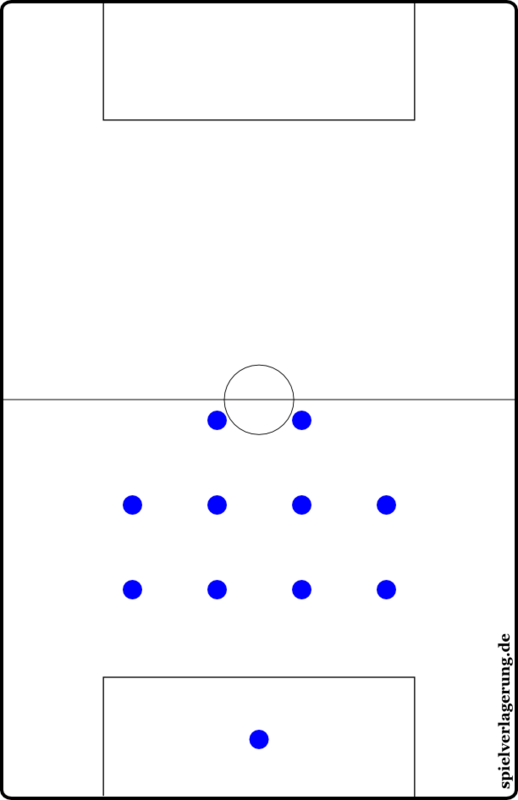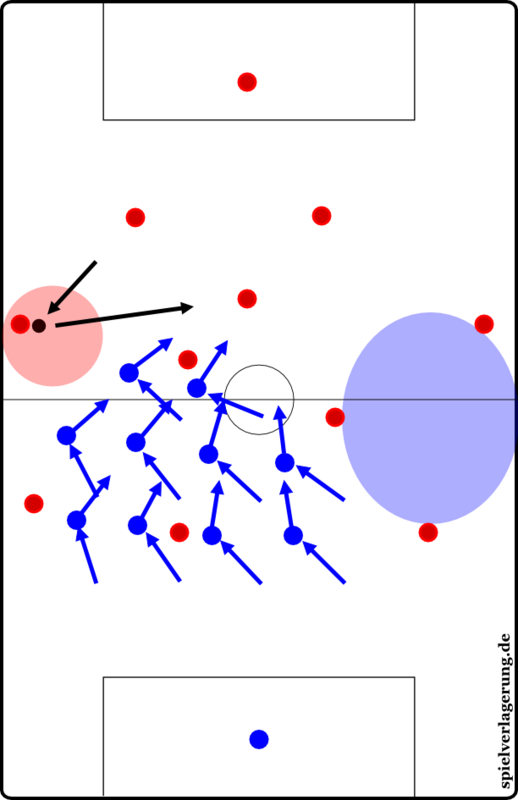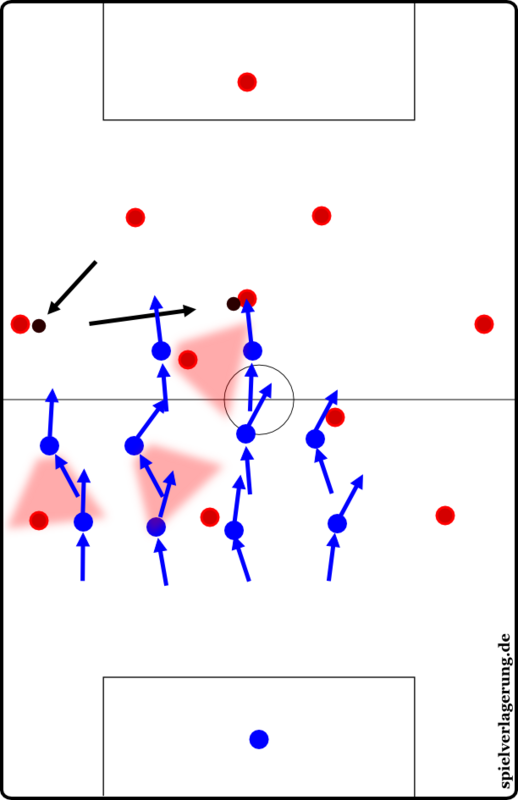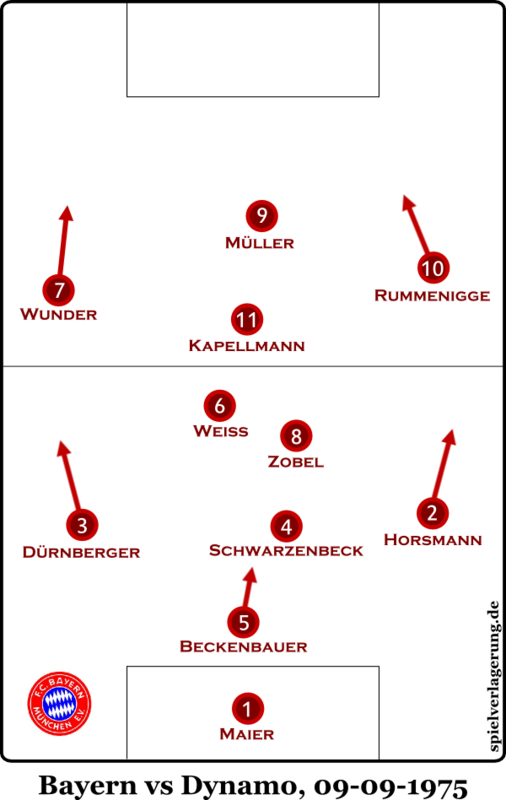◆始めに
今回の記事のテーマはゾーンディフェンスになります。
日本サッカーの世界では広まっているとはまだまだ言い難い守備戦術なのですが、
欧州では一般常識として身に付けていて当然の扱いをされています。
ゾーンディフェンスとはなんぞや?という文章を探してみたけれど、
検索に引っかかるのはトレーニング方法ばかり。理論的な話はほとんど見つけられませんでした。
それだけ説明するものではない常識になっているのでしょうか。
今回紹介する文章、画像はすべて以下のサイトから引用しています。
http://spielverlagerung.com/2014/07/01/zonal-marking-zonal-coverage/
著者はRene Maric氏(https://twitter.com/renemaric)。レッドブル・ザルツブルクのアシスタントコーチをしている方のようです。
そして原文のドイツ語から英語に翻訳しているrafamufc氏(https://twitter.com/rafamufc)・・・
サウジアラビアの方のようで、全てアラビア語で書かれているので何をしている人なのかはちょっと分からなかったですw
以下、本文になります。
Zonal Marking / Zonal Coverage
The two main types of defense used in soccer are man-marking and zonal marking.
In this article we will explain the different types of zonal marking and their advantages and disadvantages.Written by Rene Maric
Translated by @rafamufc
ゾーンディフェンス
サッカーの守備に使われる手法はマンマークとゾーンディフェンスの大きく2つに分かれます。
この記事ではゾーンディフェンスの種類とメリット、デメリットについて説明していきます。
著者 Rene Maric
翻訳 @rafamufc
General information about Zonal Marking
Zonal marking was the first way defense was played.
The original zonal marking had very little to do with the modern style because it lacked organization.
One might call it chaos marking as everyone just sort of stood around and occasionally tried to win the ball.
ゾーンディフェンスの基本情報
ゾーンディフェンスはサッカーの歴史上で最初に行われた守備方法です。
オリジナルのゾーンディフェンスは組織的な動きに欠けていたので、現代のそれとはあまりつながりはありません。
誰もがボールの周りを取り囲み、奪い取ろうとしていたため混乱を呼ぶだけだったようです。
Today, zonal marking is anything but chaotic.
The advance of athleticism, game intelligence, and especially the professionalization of football, have led to the dying out of man-marking as players are individually stronger and better coordinated as a team.
The gaps are now narrower and better covered, which mitigates the vulnerability of zonal marking between the horizontal and vertical lines.
今日のゾーンディフェンスは混沌としたものではありません。
運動能力、知識の向上に加えてサッカーがプロ化して選手たちが個々に強度をました事により、
良いチームを作るためにマンマーキングは徐々に衰退していきました。
現在、水平と垂直の守備ラインの間にあるギャップは狭くよりよく覆われているため、ゾーンディフェンスの弱点は緩和されています。
In the late eighties, zone defense was extended further by Raumvernappung (squeezing space).
In this style, the game was basically kept compact and the effective playing field compressed by the factors of time, space, and the offside rule.
Arrigo Sacchi trained his players to use fuor reference points:
80年台後半にはゾーンディフェンスはRaumvernappung(ドイツ語:スペースを絞るという意味)としてさらに発展してきます。
このスタイルでは試合中、基本的には布陣をコンパクトに保ち、時間、空間、オフサイドルールの要素によってプレーできる場所は圧縮する事になります。
アリゴ・サッキは選手たちに注意すべき4つのポイントを説明しました。
“Our players had four reference points: the ball, the space, the opponent and his own teammates.
Every movement had to happen in relation to these reference points.
Each player had to decide which of these reference points should determine his movements. “
– Arrigo Sacchi
「選手達は次の4つを注意します。ボール、スペース、相手、そして味方です。
すべての動きはこれら4つに関係しています。
どの選手もこれらのポイントに注意してどんな動きをするか決めるのです。」
by アリゴ・サッキ
In order to play zonal coverage, the team must consider these reference points when shifting and pressing to remain stable and prevent opening any holes.
安定したスライドやプレスをかけたり穴を開けたりしないために、ゾーンディフェンスをするチームは基準を決めなくてはいけません。
That being said, it should be noted that playing a ball-oriented game is not zonal marking.
The ball-oriented game refers to the adjustment of the player and his team to the movement of the ball.
Which, in zonal marking, is usually applied much more when pressing and squeezing space.
ボール志向ゲームをすることがゾーンディフェンスでは無いことに注意してください。
ボール志向ゲームとはボールの動きに対して選手とチームを調整することを指します。
ゾーンディフェンスとは、スペースをより圧縮する目的で使われます。
Theoretically, it is possible to play zonal marking without being ball-oriented.
It used to be quite common to not man-mark but mark space; yet not indent or constantly move in the direction of the ball at all.
理屈としてはボール志向という考えなしではゾーンディフェンスを行うことは不可能です。
ボールの動きに沿ってあちこち行ったりせず常に動いている事もなかったので、かつてはマンマークではなくスペースを守る事は一般的でした。
It is also a mistake to believe that Sacchi’s four reference points only apply to squeezing space and pressing.
They are generally used in the defensive game and the attacking game, which has the added benefit of the reference points providing reasons for playing the different types of zonal marking.
アリゴ・サッキの示した4つのポイントはスペースを圧縮するためだけに焦点をあてていると考えるのは間違いです。
ゾーンディフェンスを変形させて、さらにプレーの焦点を加えることにより守備でも攻撃でも活用できるようになります。
Zonal marking as a team
First, we will explain collective zonal marking, which is practiced by the entire team, and its variants.
ゾーンディフェンスとは集団である
最初にチーム全体で作られるゾーンディフェンスとそのバリエーションについて説明します。
図1
For easier understanding all of the scenes in this article will be based on a 4-4-2 formation in defense
わかりやすくするためにこの記事では4−4−2システムを基本にします。(図1)
Variant 1: Position-oriented zonal marking
In position-oriented zonal marking, the player’s reference point is his “teammates”.
The team simply operates in a closed block.
This ‘block’ is nothing but a formation, in which the respective positions are clearly defined and a player “covers” his own position.
The term position marking could also be used.
バリエーション1:ポジション指向のゾーンディフェンス
ポジション指向のゾーンディフェンスでは「味方」を注目します。
チームは閉じられたブロックとして単純に動きます。
「ブロック」とはフォーメーションでは無く、選手達はそれぞれ取るべきポジションをはっきりと定義されて自分のポジションを「カバー」します。
「ポジションマーキング」といった用語で表現することもあります。
Some examples include Lucien Favre’s Gladbach or Valeriy Lobanovskyi’s Dynamo Kyiv.
At Gladbach, it is striking how effectively they move back and forth while often exerting little pressure on the opponents or the ball.
Instead, they focus on thwarting attacks by controlling space.
If the opposing team resorts to circulating the ball, Gladbach move so quickly and precisely that the supposedly “open” wings can’t be played.
幾つかの例として、リュシアン・ファーヴルのボルシアMGとヴァレリー・ロバノフスキーのディナモ・キエフが挙がります。
ボルシアMGでは選手が前後に動き回る事で特に効果を発揮しています。
相手やボールに対してかけるプレッシャーは少ないのですが、代わりにスペースをコントロールして相手の攻撃を防ぐ事に重点を置いています。
もし相手チームがボールを回したとしても、ボルシアMGは素早く正確に動き、相手のウイングにプレーさせないでしょう。
At the same time, the vertical and horizontal compactness is preserved, so the opponent can hardly find space within the block.
If they try to play into the narrow space, then the lines move toward each other (or only one line moves, depending on the game philosophy) and closes the space.
Over time, this puts the opponent under pressure; resulting in winning the ball off bad passes or other technical errors.
同時に縦方向と横方向をコンパクトに保つ事によって、相手はブロックの内側にスペースを見つける事が難しくなります。
もし狭いスペースでプレーしようとしたら、守備ラインは互いに近づき(チームの方針によっては一つのラインだけが動きます)スペースを閉じます。
そのうちに相手にプレッシャーが掛かり、結果としてパスミスやその他のミスをさせてボールを奪い取ります。
The characteristics of position-oriented zonal marking are: clearly recognizable banks in defense and midfield, giving space to the opposition on the wings, and straight lines.
However, the formation must not consist of equally wide chains or equal spacing between the various parts of the team.
The goal is to keep the gaps and the space between the lines as small as possible.
ポジション指向ゾーンディフェンスの特徴はディフェンスと中盤にはっきりとした守備ラインを作れる事です。
一方で相手ウイングに一直線にスペースを与えることになります。
フォーメーションとしては、チームのどこの部分でも等しい間隔、空間を保たなければいけません。
最終目標はライン間のギャップとスペースを出来るだけ小さく維持し続ける事になります。
In effect, this often looks somewhat passive because little pressure can be generated against an intelligent and cautious ball circulation.
This season, Favre played it so that he pulled apart the space between the lines or intelligently moved the lines up to establish access for their pressing.
事実として相手チームの巧みなボール回しに対してあまりプレッシャー掛けることが出来ないので、この守備方法はやや受動的に見える守り方です。
今シーズン、ファヴレはラインの間のスペースを引き離したり、巧みににラインを挙げることでプレスを掛ける手法を確立しました。
ポジション指向のゾーンディフェンスの例
The opponent builds play on their right side, with what seems to be a 4-1-2-3 as a variation of the 4-3-3 with wide wingers.
For illustrative reasons, we (blue team) are standing in an ultra-defensive formation.
ウイングが幅を取る4−3−3のバリエーションである4−1−2−3システムをつくり、対戦相手は彼らの右サイドでビルドアップしています。
この図では青チームは極めて守備的なフォーメーションをとっています。
The opponent plays to the right and the team moves as a group to that side of the pitch.
The space that appeared to be open on the side for the winger is suddenly very tight and can not be safely played.
The ball goes into the center and our (semi) left striker gets access and moves to press.
The team follows his example and take the same running paths.
相手が右サイドでプレーしようとした時、青チームはグループとしてピッチの端に移動します。
相手がウイングのために開けていたサイドのスペースは青チームは移動することによって急に狭くなり、安全にプレーできなくなります。
ボールが中央に戻されると、青チームの左FWはプレスを掛けに行きます。
青チームはFWの動きに従って同じ経路で動きます。(図2)
The opponent is approached slowly and step by step, which sometimes seems a bit laid-back.
Despite the passivity and reduced access, however, the block remains stable and compact.
Passes into the space between the lines are difficult and can be compressed by narrowing the team’s spacing.
ときおり緩めているように思えますが、対戦相手はゆっくりと徐々にアプローチを仕掛けられています。
受け身の守備で相手に近づく動きでは無い代わりに、守備ブロックは安定してコンパクトなままです。
スペースを狭く圧縮することができ、守備ラインの間にパスを通すことを難しくさせます。
Variant 2: Man-oriented zonal marking
人指向ゾーンディフェンス
In man-oriented zonal marking, you play with a basic formation in which the reference point is the “opponent.”
From their respective base positions, the players orient themselves flexibly in the space they cover in order to maintain a certain distance to the opponent closest to them.
人指向ゾーンディフェンスでは、「相手」を焦点として基本のフォーメーションを組みます。
それぞれの基本となるポジションから、プレイヤーは自分に最も近い相手と一定の距離を維持するためにカバーしているスペース内で柔軟に対応します。
The contrast to man-marking is obvious.
In man-marking, a player sticks very tight to an opponent, oftentimes even tracking just the one opponent.
In zonal marking, a player must cover the space around his position, loosely moving his position to any nearby opponent and staying close to them.
マンマークとの違いは明らかです。
マンマークでは選手は相手に張り付き、ほとんどの場合は1人の相手にずっとついていきます。
ゾーンディフェンスでは選手はポジション周辺のスペースをカバーしなくてはなりません。近くにいる相手に対してポジションを移動して近づいた状態を維持します。
In a way, it’s a compromise between position-oriented zonal marking and man-marking.
The advantage over man-marking is fewer open holes.
The advantage over position-oriented zonal marking is the increased access gained via the shorter distance to the opposition.
ある意味ポジション指向ゾーンディフェンスとマンマークとの間の妥協点とも言えます。
人指向ゾーンディフェンスがマンマークと比較して有利な点はスペースをあけづらい事です。
ポジション指向のゾーンディフェンスと比較すると、より相手との距離を縮められて関わりやすくするという利点があります。
人指向のゾーンディフェンスの例
The opposing right-back receives the ball, so our team shifts to the left.
It is striking that our sixes behave differently: one is based on the opponent’s right eight, one on their center forward.
Our striker is also man-oriented, however not in the classic sense, but in space: he cuts off the passing lane for the opposing six, who is playing behind the other eight.
相手の右サイドバックがボールを受けたので青チームは左に寄っていきます。
2人の6番選手(*1)の振る舞いに違いがあるのが特徴です。1人は相手右の8番選手(*2)につき、もうひとりはセンターフォワードにつきます。
青チームのFWは人指向ですが、古典的なマンマークではなく受け持つスペースがあります。彼は相手6番選手へのパスコースを切ります。(図3)
(*1)6番選手・・ドイツでは守備的な役割をするMFを6番と表します。
(*2)8番選手・・攻撃的なMFです。
Alternatively, our other six could have oriented to the opposing left-half eight and the winger would have remained in space.
So all the pass routes and options are blocked directly (by cover shadows or even situational man coverages) or indirectly (through access and narrowness).
あるいは、青チームの6番選手は相手逆サイドの8番またはスペースに残っているウイングをカバーします。
そうすると全てのパスコースや選択肢を直接的(カバーシャドウ(*3)をしたり、状況に応じて人につく)または間接的(スペースを狭くする)にブロックします。
(*3)カバーシャドウ・・・自分の背後に相手選手がいるようにパスコースを塞ぐポジションを取ること。
The opposing full-back does not risk the line pass, but plays back.
Our team therefore pushes out.
The striker separates from the space around his opponent and begins to press.
The far winger pushes out and, until the opposing center back handles the ball and continues playing, our winger is again near the opponent’s left-back.
Our left six runs past the opposing right eight and is now “suddenly” oriented on the six of the opposing team.
相手サイドバックにはリスクが無い、線で引かれたようなコースにパスを出して後ろに戻します。
その時に青チームは押し上げます。
FWは自分の担当しているスペースから飛び出してプレスをかけ始めます。
相手のセンターバックがボールを受けた時に離れた場所にいるウイング(*4)は押し上げ、近くにいる相手の左サイドバックに寄せます。
相手の右8番選手に付いていた青チームの左6番選手は、相手の6番選手に向かっていきます。
(*4)ウイング・・3トップのサイドではなく、ここではサイドに張っているMFになります。
In a way, one could say that man-oriented zonal marking, in contrast to position-oriented zonal marking, does not wait for access and pressing, but seeks it.
The difference to man-marking is that the opponent will not be tracked or handed over to another teammate, but left to stand in space, and one can reorient themselves at any time.
Furthermore, one does not focus on the opponent, but the action space and the access distance.
ポジション指向のゾーンディフェンスと比べると人指向のゾーンディフェンスはプレスを掛けに行きやすいと言えます。
マンマーキングと違う所は、相手をおいかけ続けるのではなく味方にマークを受け渡すところです。そうしてスペースにとどまる事によって再び相手を捕まえることができます。
さらに相手に焦点を当てていないので、スペースと味方との距離を保ちやすいです。
Variant 3: Space-oriented zonal marking
スペース指向のゾーンディフェンス
In this third variant, which is used much less frequently than man- and position-oriented zonal marking, the reference point is space.
The team shifts toward the effective playing space “in the moment” and tries to occupy it.
3つ目はスペースに焦点を当てるゾーンディフェンスです。人指向やポジション指向のゾーンディフェンスに比べるとほとんど使われていません。
チームは”現時点で”効果的なスペースに移動して、そのスペースを占領しようと試みます。
On paper, one might think that sounds intelligent.
The space would be overloaded and the opponent’s short pass combinations would be destroyed by a lot of pressure.
In practice, however, this is not the case, if the opponents are even remotely smart.
They can move into the many open spaces, particularly away from the ball, and destroy the opponent’s formation.
紙の上では知的な動きをしているように聞こえるかもしれません。
スペースに負荷を掛けることによって、プレスを掛けて相手のショートパスの連携を崩すことが出来ます。
けれども実際には相手チームが賢くプレーすると上手くはいきません。
特に離れた場所にあるオープンスペースにボールを移動させると、対戦相手の陣形を崩す事ができます。
One example was the match between Valencia and Malaga, where Valencia wanted to restrict Malaga’s fluidity and situational narrowness with a space-oriented zonal marking, which failed completely.
バレンシアとマラガの試合を例とします。バレンシアはスペース指向のゾーンディフェンスによってマラガの流動性を押さえ込もうとしましたが、完全に失敗しました。
スペース指向ゾーンディフェンスの例
In a sense, it was the lost twin of man-marking; in terms of idiocy.
The pass goes as usual to the opposing right-back and the entire team is oriented on the new space.
それはある意味、失われたマンマーキングにそっくりでした。愚かというしかありません。
いつも通り右サイドバックにパスが出されると、チーム全体があらたなスペースへ移動します。
They have no access, the pass goes into the middle, and they move there.
What happened?
近づくことができずパスは中盤に戻され、彼らはまたその場所に動きます。
何が起きるのでしょう?
Right, away from the ball the space is wide open.
Every variant of zonal marking (with space squeezing, at least) results in open spaces, but in space-oriented zonal marking they arise throughout as a natural occurrence. They will also be so large that they can be played not only on long dangerous diagonal balls but, from halfway intelligent adversaries, through short passing combinations – as in this case.
右サイド、ボールから離れた場所に大きくスペースが空いています。
どの種のゾーンディフェンスでも(スペースを圧縮するので)結果的には空けてしまうスペースが存在します。
スペース指向のゾーンディフェンスでは、自然発生的にスペースを空けてしまいます。
大きくスペースをあけると、ななめに危険なロングパスを出されるだけでなく、賢い相手ならハーフウェイライン辺りからショートパスの連携で突破される事になるでしょう。
In the game between Valencia and Malaga, Valencia tried this coverage to some extent and failed.
In this article you’ll find a few nice pictures from laola1.tv including a brief explanation.
バレンシアとマラガの試合で、バレンシアはこの守り方を試しましたが失敗しました。
この記事(リンク)から簡単な説明がついている画像を見つけられるでしょう。
Option 4: Option-oriented zonal marking
選択肢指向のゾーンディフェンス
With the option-oriented or even ball-oriented zonal marking, the reference point is the ball – how can it harm us, how do we prevent that?
The team moves out of position differently, depending on the position of the ball and the opportunities that arise for the opponents.
その他のゾーンディフェンスとして選択肢指向ゾーンディフェンスがあります。ボール指向のゾーンディフェンスとも言います。
これはボールを焦点に置きます。どんなメリット、デメリットがあるでしょう?
相手によって動かされたボールの位置によって別の場所へと移動します。
This option was practiced by Laudrup’s Swansea and, to some extent, FC Barcelona.
It is important that the players play smart and are well coordinated, otherwise numerous holes will be opened and the formation torn apart.
このオプションはラウドルップ監督のスウォンジーやバルセロナで実践されています。
重要なのは選手達が賢くバランスよくプレーすることです。そうしなければたくさん穴を空けてしまいフォーメーションは崩れてしまいます。
ボール指向のゾーンディフェンスの例
It’s the same scenario, but with different movements.
The opponent passes to the right-back (“our” left) and our team moves.
However, our right-back thinks, “Well, hey, if they play a sexy diagonal ball, there’ll be trouble” and breaks off from the chain.
同じような考え方ですが、これまでのゾーンディフェンスとは動き方が違います。
相手の右サイドバックに(守備側の左)にパスされると青チームは動きます。
けれども青チームの右サイドバックは考えます。「もしダイアゴナルに良いパスを出されると危険だ」そうして横の味方とのつながりを切って動きます。
Our left winger cuts off the opponent’s right winger in his cover shadow, while the left six prevents a dangerous pass coming to the opposing center-forward through the open space.
The left striker cuts off the opposing right eight with his cover shadow.
His partner, the right striker, therefore moves up in anticipation.
青チームの左サイドの選手は相手右ウイングへのパスコースを切ります。それに続いて6番選手はフリーでいる相手のセンターフォワードへのパスコースを切ります。
青チームの左FWは相手の右8番選手のパスコースを切ります。
相棒である右FWは次のボールの動きを予測して動きます。
Why does he move up?
We can see it in the attack development.
The opposing right-back’s pass is risky, the left striker tries to intercept him, fails and runs wider; now cutting off the opposing right-back in his cover shadow.
The second striker can now press and attack the opponent’s six.
なぜ彼はこのような動きをしたのでしょう?
攻撃の組み立ての時にこの様な場面を目にします。
青チームの左FWはインターセプトを狙っているので、相手右サイドバックのパスはリスクがあります。
パスを失敗するか、相手右サイドバックからのパスコースは消されているのでサイドを上がるくらいでしょう。
第2FWはプレスをかけて相手6番選手に迫ることができます。
Our team moves on, the far winger focuses on the flank.
If we win the ball, he thrusts into space.
If it is passed off, he covers the far side from diagonal balls.
青チームが動いている時、青チームのウイング(右サイドの選手)は相手のサイドに注目しています。
もしボールを奪えれば、彼はスペースに走り込むでしょう。
もし相手チームにバスを出されたら、彼はダイアゴナルパスを防ぐためにファーサイドをカバーします。
Zonal marking as an individual
独特なゾーンディフェンス
Under certain circumstances, zonal marking can be operated in mixed or man-marking systems with “space-markers”.
Even if this is not the norm, we will dedicate ourselves briefly to two such options.
Though the possibilities are probably endless.
特定の状況で、ゾーンディフェンスはマンマークと「スペースを守る守備」を混ぜて運用されます。
標準的な方法ではないですが、2つのオプションを紹介したいと思います。
可能性は無限大です。
Option 1: The Libero
オプション1:リベロ
The most famous free man in the history of football is the libero.
He traditionally played behind a defensive line and had no opponent to mark, covering open spaces.
The libero wanted to plug the many holes left open by man-marking.
Behind the tempestuous man-marking line, the libero was solid as a rock; positioning himself behind holes in anticipation of intercepting passes or taking over from a vacating teammate.
サッカーの歴史で最も有名なフリーマンはリベロです。
リベロはデフェンスラインの背後に位置し、特定のマークを持たずスペースをカバーします。
リベロはマンマークによって出来た穴を塞ぐのが目的です。
激しいマンマーキングの背後でリベロはインターセプトを狙ったり、味方が外されて出来た穴を防ぐポジションを取り岩のようにしっかり守ります。
Bayern’s formation in the 1975 European Super Cup against Dynamo Kyiv, with Beckenbauer playing as libero behind a man-marking team.
1975年ヨーロッパスーパーカップ、ディナモ・キエフ戦でのバイエルンのフォーメーション。
ベッケンバウアーはマンマークのチームの背後をリベロとしてプレーした。
Option 2: Space interpreter and zonal marker
スペース管理者、ゾーンマーカー
Some players act as free agents in front of the defense; sometimes even in zonal-marking systems.
They play a role isolated from the formation or a different zonal-marking than their teammates.
So, a defensive six could be the only one in his midfield playing position-oriented, and thus hold his position while his teammates man-mark or organize their man-oriented zonal marking.
ゾーンディフェンスをとる時に、ディフェンスラインの前でフリーマンとして振る舞う選手がいます。
彼らはフォーメーションからは外れていたり、チームとは違ったゾーンディフェンス方法を取ります。
守備的な6番選手が中盤で一人だけポジション指向でプレーするとします。
彼はチームメイトがマンマーキングや人指向ゾーンディフェンスを取る時でも一人ポジションを保ちます。
On the other hand, a ten could also play as a “hunter” and always orient towards where the opponent is playing.
Then he would repeatedly swing from a number ten role to the half positions and make space there compact.
一方で10番選手が「ハンター」としてプレーする、常に相手がプレーしている場所に向かうようにさせます。
すると彼は10番の役割から中間ポジションを取るようになり、コンパクトさを作ることが出来るでしょう。
Anything else?
他の種類はあるのか?
Actually, very much so.
One can still incorporate a lot more reference points to put a greater emphasis on pressing and especially counter-pressing, and build new zonal marking options.
Time coverage would be possible as well as ball coverage, structure coverage, Dynamik coverage and much more.
実際のところあるのです。
プレッシングやカウンタープレスを特に重視した焦点を依然として多く組み込む事ができるのです。
そしてそれは新しいゾーンディフェンスの型になります。
時間、ボール、チーム構造、ダイナミック?などそれ以外にも焦点にできます。
There are also tons of different variations to the previously mentioned zonal marking styles.
These relate to movement, the involvement in the defensive work (see Cristiano Ronaldo’s “gambling”),the exact implementation of the defensive positional play, asymmetric possibilities, the defense’s behavior when switching to the base formation and back, etc., etc.
これまでに説明してきたゾーンディフェンスの型以外に異なるバリエーションはいくつかあります。
次のような動きです。
デフェンスにあえて関わらない(クリスティアーノ・ロナウドの「ギャンブリング」)、
守備時の正確なポジショナルプレーの実行、
非対称システムの可能性、
基本システムから守備時の振舞いをきりかえる、
などなど。
This list above is intended to provide only a general overview of the two large and two smaller uses of zonal marking; outside of these four variants, there are still ways to create new ideas; within these four variants there are also an incredible number of variations.
上記のリストはゾーンディフェンスをつかうにあたり2つの大きな概念と2つのより小さな概念によって導き出されています。
ここまで解説してきた4つのゾーンディフェンス手法(*5)の中にも非常に多くのバリエーションがあり、まだ新しいアイデアを見つける方法はあります。
(*5)・・ポジション指向、人指向、スペース指向、選択肢(ボール)指向の4つ
How does the chain move when a player leaves position to press?
Does one press backwards, or return to their position?
How exactly do you decide who presses backwards and what do the remaining players do in their positions?
Who provides defensive security and when?
ポジションを離れプレスト掛ける時にどうやって連動した動きをするか?
後方に居る選手にまでプレスを掛けに行くのか、それともポジションに戻るのか?
後方に居る選手プレスを掛けに行く、もしくはポジションを維持する事をどのように決断するのか?
いつ誰が守備の保証を行うのか?
The possibilities are endless thanks to the countless combinations and the many complex facets of the game, Which is what makes football so incredibly diverse.
サッカーは非常に多様性をもっているので、試合中には数え切れないコンビネーションとたくさんの複雑の事象が絶え間なく続いていきます。
Even as a standard the use of a zonal marking system is not clearly defined.
Most teams mix it up positionally.
Using situational or flexible man-marking and varying them in the different phases of the defensive game.
Starting from a position-oriented zonal marking against the opponent’s deep buildup in order to remain stable and organized, then, switching to a man-oriented zonal marking when the opponent is higher, in order to get faster access.
During the pressing phase, they are then option-oriented and cover the potential passing lanes or something similar.
As you can see, a defensive standard does not exist.
ゾーンディフェンスは一般的に使われていますがはっきりと定義されていません。
大抵のチームが混ぜ合わせています。
状況に応じて柔軟にマンマーキングをつかうことで守備の局面を変えています。
対戦相手のビルドアップに対して、安定した組織を作るためにポジション指向のゾーンディフェンスからはじめ、
そして相手が高い位置をとりだしたら、より早くプレスを掛けるために人指向のゾーンディフェンスに切り替える、
次にプレスを掛ける局面では、選択肢指向のゾーンディフェンスでパスを通すコースをカバーします。
このように守備方法は一つに決まるものでは無いのです。





